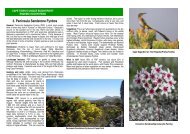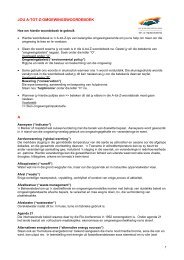Our coastline – priceless! - City of Cape Town
Our coastline – priceless! - City of Cape Town
Our coastline – priceless! - City of Cape Town
Create successful ePaper yourself
Turn your PDF publications into a flip-book with our unique Google optimized e-Paper software.
Animals along our coast - marine<br />
WHALES<br />
Southern right whales<br />
visit our waters between July<br />
and November every year to<br />
mate and calve. As they were<br />
intensely hunted in earlier years,<br />
only about 10% <strong>of</strong> the original<br />
population remains.<br />
DOLPHINS<br />
Common dolphins are likely<br />
to be seen east <strong>of</strong> <strong>Cape</strong> Point,<br />
or in deeper waters.<br />
SHARKS<br />
Humpback whales migrate<br />
up our coast to breed further<br />
north. Males are known for their<br />
haunting songs that last from<br />
10 to 20 minutes, and can be<br />
repeated for hours at a time.<br />
Bottlenose dolphins are also<br />
likely to be found east <strong>of</strong> <strong>Cape</strong><br />
Point, or in deeper waters.<br />
Ragged-tooth sharks are <strong>of</strong>ten seen in<br />
aquariums. Despite their fearsome looks,<br />
they are virtually harmless to humans.<br />
They can swallow air to become buoyant<br />
and hover motionlessly in the water.<br />
SUNFISH<br />
Bryde’s whales occur in<br />
our waters all year round<br />
<strong>–</strong> usually quite a distance<br />
<strong>of</strong>fshore. Their name is<br />
pronounced ‘Brew-dus’,<br />
after the Norwegian who<br />
built the first whaling<br />
stations in Durban.<br />
Dusky dolphins are very<br />
acrobatic and usually found<br />
close to the shore on the<br />
West Coast.<br />
Killer whales have<br />
occasionally been spotted<br />
in False Bay during March<br />
and April, hunting schools <strong>of</strong><br />
common dolphins.<br />
9<br />
Heaviside’s dolphins are<br />
sometimes called Benguela<br />
dolphins, as they appear to<br />
prefer the cold water <strong>of</strong> the<br />
Benguela current.<br />
Great white sharks have become<br />
iconic in <strong>Cape</strong> <strong>Town</strong>. This is also the<br />
only area where great white sharks<br />
are known to breach while hunting.<br />
This unusual fish draws its name from a habit <strong>of</strong> lying on its side on the surface <strong>of</strong> the sea, as if<br />
sunbathing. On average, these creatures weigh around 1 ton. As they feed on animals such as jellyfish<br />
and bluebottles, they pose no threat to humans. Even so, they are <strong>of</strong>ten mistaken for sharks because<br />
<strong>of</strong> their angular dorsal fin that sticks out above the water. (Remember, a shark’s dorsal fin moves in a<br />
straight line, while a sunfish’s fin zigzags.)<br />
Illustrations: Whales and dolphins by Noel Ashton (www.noelashton.com), ragged-tooth shark and sunfish by Izak Vollgraaff, terrestrial animals<br />
and great white shark by Leigh van Olst.

















